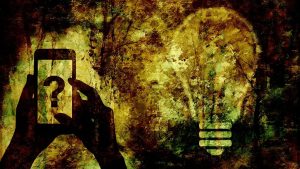Media and digital literacies
In the previous section, you read about some of the problems associated with participatory culture. As more and more people get involved in digital and networked communication, things get complicated: yes, there are new opportunities, but there are also new challenges.
One solution to the challenges posed by participatory culture is that citizens become trained to be more competent users of media and digital technologies: they develop their media and digital literacies.
Media literacies are the skills and competencies that allow individuals to read, access, analyse, evaluate, share, and create media content, and to understand and participate in media processes. A media literate person, according to a much-cited definition, can “decode, evaluate, analyze and produce both print and electronic media” (Aufderheide 1993: 1). This definition was the product of an historic 1992 meeting of media educators and media literacy advocates convened by the Aspen Institute in the US, whereupon it was agreed that to be “media literate” means to understand the following:
- media are constructed, and construct reality
- media have commercial implications
- media have ideological and political implications
- form and content are related in each medium, each of which has a unique aesthetic, codes and conventions
- receivers negotiate meaning in media.
(Aufderheide 1993: 2)
In other words, media literacy allows individuals to be aware of the ways in which communication shapes reality. Media theorist James Paul Gee describes such knowledge as an understanding of “how people give meaning to and get meaning from media” (2015: 33).
Media literacy also encompasses knowledge about the operations, structure, and imperatives of the media industries. As Renee Hobbs puts it, media literacy education “pulls back the curtain on the political economy of the media” (Hobbs 2019: 3). In this sense, media literacy is about power: understanding the power relations that underscore the production and distribution of media, and empowering oneself through the acquisition of this knowledge.
Debated, dissected, and advocated for throughout the latter decades of the twentieth century, media literacy remains a hot topic in the twenty-first century and in the thick of participatory culture. Today, the most nuanced definitions of media literacy consider it to be both an ongoing process and a life skill. Hobbs, for example, describes media literacy and its sister term, digital literacy, as “a constellation of life skills that are necessary for full participation in our media-saturated, information-rich society” (2010: xii). And while media literacy is often described as the product of formal media education, it can also be acquired through informal learning processes, for example through our participation in online communities where mentorship may help us sharpen our digital communication skills.
So if we are all participants in a complex process through which communication shapes meaning, and in which digital practices have meaning, we need media literacy. We need to ask questions, fact-check, and interpret and remake representations. Yes, a knowledge of the workings of digital platforms and the affordances of social and digital media will help you make an impact as a communicator. But as I wrote in Chapter 1, we don’t study communication just because we want to do it better. We study communication because we have questions, and the questions – like it or not – see us unpicking the seams of common sense.

Media literacy and misinformation
Is media literacy the answer to the misinformation problem? Perhaps. A media literate person can discern truth from falsity more easily, and can detect media bias. But, as danah boyd warns us, we shouldn’t think of media literacy as the “silver bullet” solution to the complex problems of the digital age. Boyd (2018) suggests that we focus more on the teaching of interpersonal skills, so that young people who are rapidly acquiring the competencies that allow them to create and share content on YouTube, Reddit, Discord, Instagram, and countless other digital platforms also have the ability to empathise, to understand otherness, and to negotiate different perspectives.
And if we think of media literacy only as a protective measure, we are limiting ourselves to media effects perspectives (see Chapter 7) and neglecting the range of things people do when they communicate in digital and mediatised spaces.
But it’s also the case that media literacy can help us understand and perform our roles as communicators and audiences in an ethical way. The sense of perpetual inquiry at the heart of media literacy primes us to recognise misinformation when we encounter it. And at a time when everyday citizens can become involved in the spreading of misinformation, media literacy can slow the flow, so to speak, and encourage us to think critically and reflexively about the information we are sharing. As Henry Jenkins points out (2020), media literacy is more important than ever before when citizens are entangled in the spreading of misinformation about war, politics, climate, and health (particularly so in the pandemic years).
And this is where things get interesting, because media literacy intersects in vital ways with other literacies: health literacy, environmental literacy, social justice literacy. I began this book with an overview of some of the communication challenges that haunt our world in the early decades of the 21st century. These challenges are better confronted by media literate individuals who can share, negotiate, and recreate meanings with confidence.
Ahead in Chapter 8…

